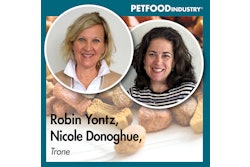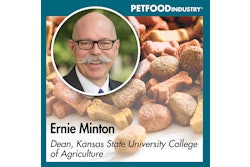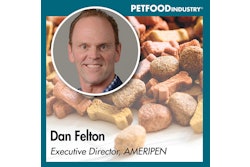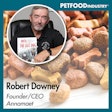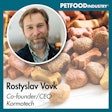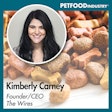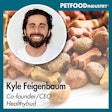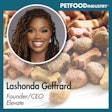
In this Trending: Pet Food podcast, host Lindsay Beaton is joined by Satoru Wakeshima with CBX to explore the top considerations when rebranding a product that has a long history and reputation.
The below transcript is from Episode 49 of the Trending: Pet Food podcast where editor Lindsay Beaton spoke with Satoru Wakeshima, partner with CBX, about what it takes to rebrand a legacy brand. You can find the episode at PetfoodIndustry.com/trending-pet-food-podcast, on SoundCloud or on your favorite podcast platform.
Lindsay Beaton – Editor, Petfood Industry magazine and Host, Trending: Pet Food podcast: Hello, and welcome to Trending: Pet Food, the industry podcast where we cover all the latest hot topics and trends in pet food. I'm your host and editor of Petfood Industry magazine, Lindsay Beaton, and I'm here today with Satoru Wakeshima, partner at CBX. Hi, Satoru and welcome.
Satoru Wakeshima, partner with CBX: Hi, Lindsay, thanks so much for having me.
Beaton: In case you're not familiar with Satoru or CBX, here's what you need to know. Satoru has guided brand strategy, design and innovation for over 25 years across more than 500 brands, including such iconic names as Milk-Bone, M&Ms, Clorox, Canada Dry, Miracle Gro, Gillette, Kraft and Coca-Cola.
Based in New York and Minneapolis, CBX is an award-winning brand design agency that offers corporate identity product portfolio architecture, package and private label design, retail activation, brand purpose naming innovation and positioning for some of the world's most beloved brands.
Satoru has extensive experience in brand strategy and architecture as well as a recent complete rebranding he was involved in of legacy brand Milk-Bone is why I’ve brought him on today to answer this question, what are the top considerations in rebranding a legacy brand?
I want to start by laying the groundwork for why this particular rebrand happened to begin with, because obviously, Milk-Bone in the pet space is iconic. Pretty much everybody knows what it is. It's very well established. So why was there interest in doing a rebrand now?
Wakeshima: There were a lot of different factors to consider. One of which is this is a 100-year-old brand. While the brand has been around forever, and people recognize the red box with the large bone and the big dog face on the package, it needs to maintain its freshness, it needs to maintain its relevancy. As the number one dog treat in the category, it needs to also show its retailers that it's keeping things fresh, that it is constantly being relevant to its audiences and appealing to its audiences.
Milk-Bone saw the opportunity, the folks at J.M. Smucker saw the opportunity to not only give it a bit of a freshening, but also see what opportunities there might be to connect better with their audiences. Something that happened during this time that we were about to start this project was COVID. During that time, lots of people acquired pets. I think the statistic was something like one out of five people now have a pet in the U.S., which is an amazing factor. With that, there is an opportunity to appeal to a slightly younger audience -- millennials and Gen Z -- but also renew its relevancy and renew its appeal with its current core consumers.
Beaton: I think that makes a lot of sense, especially for a brand that's been through 100 years of history and a lot of changes. They're probably pretty good at staying on top of that kind of thing and knowing when to rebrand.
Wakeshima: There was another aspect of this project and need for a rebranding or refresh of the brand, which was – Milk-Bone was known as product that everyone knows. People love the biscuit. They know the biscuit. It's certainly iconic when you see it, but they have a host of other products. They have all kinds of different varieties of biscuits, they have soft biscuits, they have biscuits for training, they have tiny biscuits for smaller dogs. They have a variety of different treats, and there's very little awareness of them. We wanted to make sure this was an opportunity to bring that forward and have a new design system that would allow these new products to really shine.
Beaton: Was that the primary consideration when you were doing the rebrand or were there other things that you had to consider in order to make sure you're still conveying that Milk-Bone is Milk-Bone but also updating it for the current audience?
Wakeshima: It's funny because when you're working with a brand as iconic as Milk-Bone or Clorox or M&Ms, these are all brands that have been around for a long time. People have a certain mental image in their heads of what does this brand look like? What does this brand stand for? It was really, really important for us to really study the equities and really understand what do people remember what has meaning, what has baggage? We did that through extensive research, talking to consumers -- really trying to have them help us understand what is it that they love about the brand? What are things that they remember?
When you're talking about visual equities, certainly for Milk-Bone, you have things like the red and the iconic big bone and most importantly, that great photograph -- the giant photograph of the dog. While they remember these things, are they working? Are they really connecting with our audiences? These are the things that we really wanted to consider. We wanted to make sure that we really understood the equities, so that we could not only leverage them, but capitalize on them. How can we improve them? How can we keep them even more fresh and also have them set the stage for the next 100 years?
Beaton: What were some of the top things that consumers said made Milk-Bone Milk-Bone that you wanted to make sure you carried over into the rebrand?
Wakeshima: There's this emotional thing about treating your dog. It's not just about, “oh, I'm giving my dog a snack” just like when I have a snack. It really is an opportunity to connect with your pet. It's a moment, it's an occasion, and the dog looks up at you and has those big, bright eyes, they wag their tail, they sit down patiently waiting for it. There is a connection moment that happens.
This is something that was really, really important to our audience. They really spoke about Milk-Bone and the treating occasion in this very emotional way. We saw that as an opportunity to try to capture that moment. How do you capture that moment on a package? How do you capture that moment in an ad on a website? The best way we could do that was really through the photography. Photography plays a huge role on this brand. Recognizing that it is about the dog -- people want to see a dog that's looking right at you, that's engaging with you. They also want to feel like the dog is present.
One of the challenges we had with the old packaging was the photography was starting to look a little staid. The dog looked a little bit like a bus like he would be stuffed. It was a little old looking. We wanted to make sure that we were bringing forward something that was really going to be much more of a connection-moment. That when you saw the package and you saw that dog, you were looking into his eyes, and you kind of felt that emotion.
Beaton: One of the things that's been a big conversation in the last few years in terms of branding in the pet space, and I'm assuming it's happening in the human space as well -- and you could probably tell me if I'm correct in that the assumption -- is that we're moving more away from a transactional mode between the consumer and the brand and more into wanting a personal connection, some kind of connection to the brand. You are putting money into these products, you want to know what's sitting in your pantry. If a brand can tell a really good story and really convey who they are, that is going to speak to consumers in a way that maybe 15-20 years ago, nobody really paid a lot of attention to, barring like specific types of brands that were already known for that.
It sounds like you kind of found that in the surveying that the connection between pet owner and pet and being able to convey that Milk-Bone is a part of that. But you've also worked with a lot of other brands too. Is this something that's happening all over the place? Or is this something that's unique to pet because of that human-animal bond?
Wakeshima: You raise a really good point. This is something that I think is true for all brands. People want to invest and buy and engage with brands that they feel understand them, that the brand gets them. Whatever that means. For a brand like Milk-Bone, it's like, you get how much I love my pet, you get how much joy my pet brings me. You get that I really love this moment of treating my dog.
It can be anything for a number of different brands. But really this understanding, this empathy of, “we get you, we understand you.” It's a very, very clear message.
For Milk-Bone, it was about how do we capture the joy, the joy of treating? That is a very simple word, but the more that a brand can define itself and what it stands for, and if it can be one word, even better, right? But that word, that connection, that element that shows you understand your audience -- that is critical.
That can happen across a variety of different categories.
I think people are loyal to a brand because they see that these brands understand that they use their products, it fits their lifestyle, it is part of their everyday existence. When that happens, you get people that are loyal to your brand, they are in your corner. That’s really important. You want to make sure these people stay in your corner. These are fans of your brand, and they're going to tell others, they're going to evangelize your brand.
I look at it like fans of a rock band. When you think about your favorite band, whether it's the Stones or whoever it may be, you want their next album to be great. You're already in their camp. You want their next album to be awesome. You want the songs to sound like the band that you love. You want them to be a little different, but you also really are looking forward to something that is familiar. I think it's important for a legacy brand to have that familiarity so that you can go back to the things that people love about your brand. But also, you're presenting something new, you're giving another reason why they love the brand. Again, that's something that crosses over from category to category.
Beaton: I have to believe that there are probably some risks inherent in taking on a legacy brand and going, “Okay, it's time to update.” What are some of the common missteps you've seen happen? What are just some of the major risks that you take into consideration when you sit down with the company or with the brand and go, “Okay, we're going to do this, here is what might happen and here's how we can avoid it.”
Wakeshima: Every brand has an elasticity -- how far you can stretch it. Think about it like a giant rubber band. You can stretch it and stretch it and stretch it until the point that it just snaps. That is something that we seek to understand -- how far our consumers are willing to let you stretch the brand.
This is a very testable proposition. You can look at a variety of different ways of doing qualitative, quantitative research to really assess and understand the elasticity of a brand so that you get it right. You want to make sure that you take the time to really understand what is it that can change, what is it that should change, and what are things that are really sacrilege, right? That you just want to make sure that you never, never, never touch.
It's important whenever you're working on a legacy brand, that you have this sense of “do no harm.” You want to make sure that you are really building and keeping the things that make your brand great, that people remember and understand but also, you are taking the time to push and pull.
One of the other pitfalls that goes hand in hand with this concept of making sure that you understand your elasticity of your brand is taking the time to get it right. Often today, of course, everyone is rushing, rushing, constantly trying to do things faster. We support and recognize the concept of agile, we employ that, but it is something that you need to use in the right applications. When you're dealing with a legacy brand, it's critical that you take the time to get it right. That you take the time to understand your audience. You take the time to really understand the elasticity of your brand. When it comes to the execution of it, you want to make sure that you are not cutting corners. If there is something that is critical to conveying what this brand evolution now includes, whether that's photography or illustration, or even just getting the right color -- these are things that take time, and you want to make sure you're taking the time to do it right.
I worked with a wonderful creative director years ago on a champagne brand that was hundreds of years old, and he was belaboring the shades of white. You want to work with creatives that are invested to that degree, where they are really, really passionate about what they do, and they will take the time to really take you on that journey to make sure that they're leaving no stone unturned and really paying attention to the details.
Beaton: Do you ever get any pushback from brands who maybe realize they need to do this, but there are just some elements that they they're like, “No, we can't possibly get rid of that.” How do you communicate and work with brands to make sure everybody's happy and help them understand what it is you're doing and how it's going to help them succeed?
Wakeshima: It happens all the time. Especially when you're dealing with the crown jewels of a company. When we worked on M&Ms years ago, you had all kinds of inputs from owners to the leadership of the company to the salesforce, and everyone's got an opinion.
The great equalizer is consumer research. You want to make sure that you're taking the time to do the due diligence, to prove to them that this is what your audience is saying. These are the things they will allow, and these are sacred that you want to keep. That is the ultimate equalizer in all of this, because otherwise people will have opinions on what they believe the brand should stand for and what they cannot change and what is critically important to the brand. It's not about who likes what. It's not about what people think that a consumer will gravitate toward. It really is about taking the time to do the research and improving it.
Beaton: Working on the Milk-Bone brand, what was the most -- we've talked a little bit about challenges -- but what was the hardest part for you? And what’s the part coming out of that that you're most proud of having come up with in terms of the new brand?
Wakeshima: There are so many things that were difficult. One of the key considerations that was challenged was when it came to executing the photoshoot. This all had to be done remotely because of COVID, because of quarantine, so our fantastic creative team was so dedicated and so diligent when working with a photographer, working with the client that we could do a complete photoshoot with dogs -- no less -- remotely. That is something that we're very, very proud of. The fact that we were able to get the result we wanted working in that fashion was really quite the feat.
The other thing that we're very proud of is the concept that made it to final package was something that came together very quickly. It came together very quickly early in the process -- in the creative exploratory process. We all kind of knew this is probably right, this is probably the one. When you're dealing with a legacy brand, as I mentioned earlier, you get a lot of opinions, you get a lot of people that were very concerned about change. We wanted to make sure that we gave them options -- that we show them that we really did do the due diligence. That we left no stone unturned. We also kind of knew we had the answer early on, and trying to convince our client that this is the direction that is really going to change the game, really make a difference, that was one of the hurdles.
Something people often forget also, especially when you're dealing with package design, is it's not just about appeal. It is also about communication. Packaging, unlike any other medium, must do certain things that advertising social media don't have to do. I'm talking about things like providing communication of product varieties, size, flavors, product depiction -- all these factors come into play when you're dealing with a package design.
One of the most challenging things that we had to deal with for Milk-Bone is it's a large portfolio. They have a lot of products. When you're dealing with a lot of products, it's very important that you create a portfolio architecture that makes sense and aids the consumer in navigating the whole portfolio. They don't even notice it, but they realize it's just very easy to shop. They understand how to find the products that they want to find, but they're also discovering new things and seeing them on shelf in the context of all these competitors, as well as all of the varieties of Milk-Bone.
Beaton: That's very interesting. How much consideration when you're doing a rebrand of anything is given to where that brand is going to appear? How does that affect the ideas you put forth in terms of branding a product, knowing that it's going to be either on a supermarket shelf or maybe these days, it's going to also be in an e-commerce space or in a higher-end, super-premium private store? How do you navigate that kind of thing in terms of branding and a product?
Wakeshima: These are factors that you must consider from the outset. You really need to have a clearer understanding of how the brand is showing up and where it's showing up. More importantly, how is it showing up in the context of competitors? Especially when you're dealing with e-commerce, the package, the brand itself is often appearing on a 1 ½- inch little square. That is something that we've come to realize -- you have that little moment of being able to convey the message you want very quickly and very impactfully in a very small size.
When we're looking at the different applications, we want to really consider all the different size considerations, the retail formats. Even the lighting in some of the retail stores is often terrible. The best way to do it is you have to get out there, look at stores, visit a Walmart, see it in the context of all the competitors. You’ve got to walk the aisle with your clients. You have to be there and really understand, what does the consumer see? The only way to do that is by rolling your sleeves and getting out there and doing it.
Beaton: I think that segues into the last part of our conversation, which is, if there is a company, a brand listening right now, considering doing a rebrand of a popular or a long-standing product line, what are the top things that brand needs to consider?
Wakeshima: I think we covered some of these topics. But I'll list what I believe are the most important considerations for evolving and refreshing a legacy brand.
The first is most important, which is you must be clear on what you stand for. If it can be one word, even better. What is that one message you want people to take away? Often a challenge a lot of marketers have is you want to say too much. There are so many great things that they want to talk about their brand. But really, if you could boil it down to one to three words, what are the top things that you want people to walk away with?
The second thing is understanding your equities. What do people remember? What has meaning? That is really the critical thing beyond just memory. What does it stand for? When someone says they associate a color with a brand, how does it make them feel? What do they think about when they see that color? What’s the baggage? How can you evolve these equities, this concept of brand elasticity, how far can you stretch things?
Marketers are often surprised by how much consumers will let them change if they have some clear definition of what are the things that remain the same and consistent. What are the things that are recognizable for the brand? You must talk to your audience -- you must know your audience, you must understand what their motivations are, you must understand what drives them and what informs their decisions.
Now more than ever, there are so many different choices, especially in the pet category, there are new brands constantly entering the marketplace, how can you really stand out in a sea of competitors? The best way to do that is to really, really understand your audience. What is it about your brand that they love? Because if they love your brand today, they love your brand tomorrow. Just like a rock band -- but you want to make sure that you are giving them something new and fresh that still sounds like the brand that they know and love.
Lastly, you always must be looking to the outside. Outside of your category, we have so many different influences. We're exposed to so many different brands and messages every day, whether you're just looking on your computer and looking at social media or walking a store, you are bombarded by so many different influences. We really believe that brands exist in culture, and there are always going to be outside influences. You owe it to yourself to really consider how these outside influences shape the way people perceive your brand. That is an important factor that often marketers can be myopic in looking at only their competitors and only their category. We really encourage people to look beyond that. Where can you draw inspiration and excitement by bringing in a concept that's working in another category and carrying that over to your category?
Beaton: What kind of a role does patience play in all this? How long should it take? Or does it usually take to really dive into all this stuff? Are we talking weeks, months, years -- just so people know if they're going too quickly or maybe not taking enough time?
Wakeshima: Patience plays a huge role. There's an aspect of when you're working on a very important project for a legacy brand. It's the crown jewels of the company, there's a lot of eyeballs on it, and people are expecting progress and want to move quickly. They really want to get things moving as quickly and as fast as they can. The important thing to consider is to make informed decisions, you need the inputs, you need to do the research, and you need to give your agency time. I can't emphasize that enough. As much as the agency wants to move as quickly, we can often make moves and be very, very quick in different areas of the program, but there are certain areas of a project where you want to take the time to study and take the time to learn.
You also need time to play, which I think is critically important when you're working on a legacy brand. As an agency, we get to work with a brand and play with it and tease it and push and pull it in different ways. Then we give it back to our clients, and if we're lucky, we get to do it again and continue to build on that. For us, it's critical that we have enough time to really push and pull and tease out what the possibilities are. This takes time. Creativity is not something that can be rushed. I think the best marketers are ones that recognize that and see the importance of design and the design process. They'll get involved and be a part of it. And we love that.
Beaton: Now one of the things I always like to ask when I'm speaking with somebody from an agency or a third party who helps industries do things, I have a lot of listeners who are smaller companies or medium-sized companies. They do not have unlimited funds. There are pet food companies out there who are working with like three or four people just trying to break into the space. If you don't have “agency money” yet, but you are to the point where you need a rebrand -- maybe you did an initial launch and it's been out for a year or two and now you want to refine based on what your customers have been saying or how the market has evolved in the last couple of years. What are some of the key things to focus on, to spend your money on? Is it the customer survey to see what it is they want? Is it the look of the packaging? Where do you spend your money when you don't have a lot of money to spend?
Wakeshima: Small brands and new brands, unlike legacy brands, they're typically launched anywhere between five to seven years, less than five to seven years. They haven't built a lot of equity yet. They may have some recognizability. They may have a core following. In those instances, you can still get at some of those consumer inputs through things like online surveys. You can do qualitative research online and have it be relatively inexpensive. You can still get at some of those inputs.
What we often find is for some of these smaller companies, there are founders, there are people that have been on the journey who gave birth to the brand who are so passionate about it. For us, it's about understanding their vision, understanding why they started this brand, and what are they most passionate about, because that's genuine. That's something that's real. As I mentioned earlier, if you can have this connection with your audience that shows you get them, that has that empathy, then you can really make an emotional connection. Often we find by talking to some of the founders who started the smaller brands, we can really get at the heart of -- what does this brand stand for? Why is it different? What are you really, really passionate about?
Other things that I think are lessons for some of these smaller brands is you have the ability to take risks. It's a smaller ship to turn and you have the ability to try things. If it's not working, you can fix it and try it again. That is something that I think the larger brands often envy. They want to try. You'll see large manufacturers coming out with these small brands. They're introducing small brands, or they're endorsed by an existing brand. It's made to look like a smaller brand, because they recognize that these smaller brands have an opportunity to be more fun and to be more progressive, to take chances. I think that is something that you shouldn't underestimate. You shouldn't lose sight of -- in the sense that the little guys, they can take the bigger risks and oftentimes reward is much greater for them.
Beaton: I really appreciate you taking the time to sit down with me today. Because there's been a lot of rebranding going on in the pet food industry lately. I think it's a sign of the times and a shift in the way consumers are interacting with brands. It makes it already a complex prospect. And then once you add something like the legacy component, I imagine it just takes it to another level. This is a really great conversation to be having right now. Before we go, I want to do a little plug. Where can people find more information about you? And CBX?
Wakeshima: Absolutely. Thank you so much for having me, Lindsay. You can visit our website at CBX.com or you can reach me specifically at [email protected].
Beaton: That's it for this episode of Trending: Pet Food. You can find us on PetfoodIndustry.com, SoundCloud or your favorite podcast platform. You can also follow us on Instagram @trendingpetfoodpodcast. And if you want to chat or have any feedback, I'd love to hear from you. Feel free to drop me an email: [email protected]. Once again, I'm Lindsay Beaton, your host and editor of Petfood Industry magazine, and we'll talk to you next time. Thanks for tuning in!



